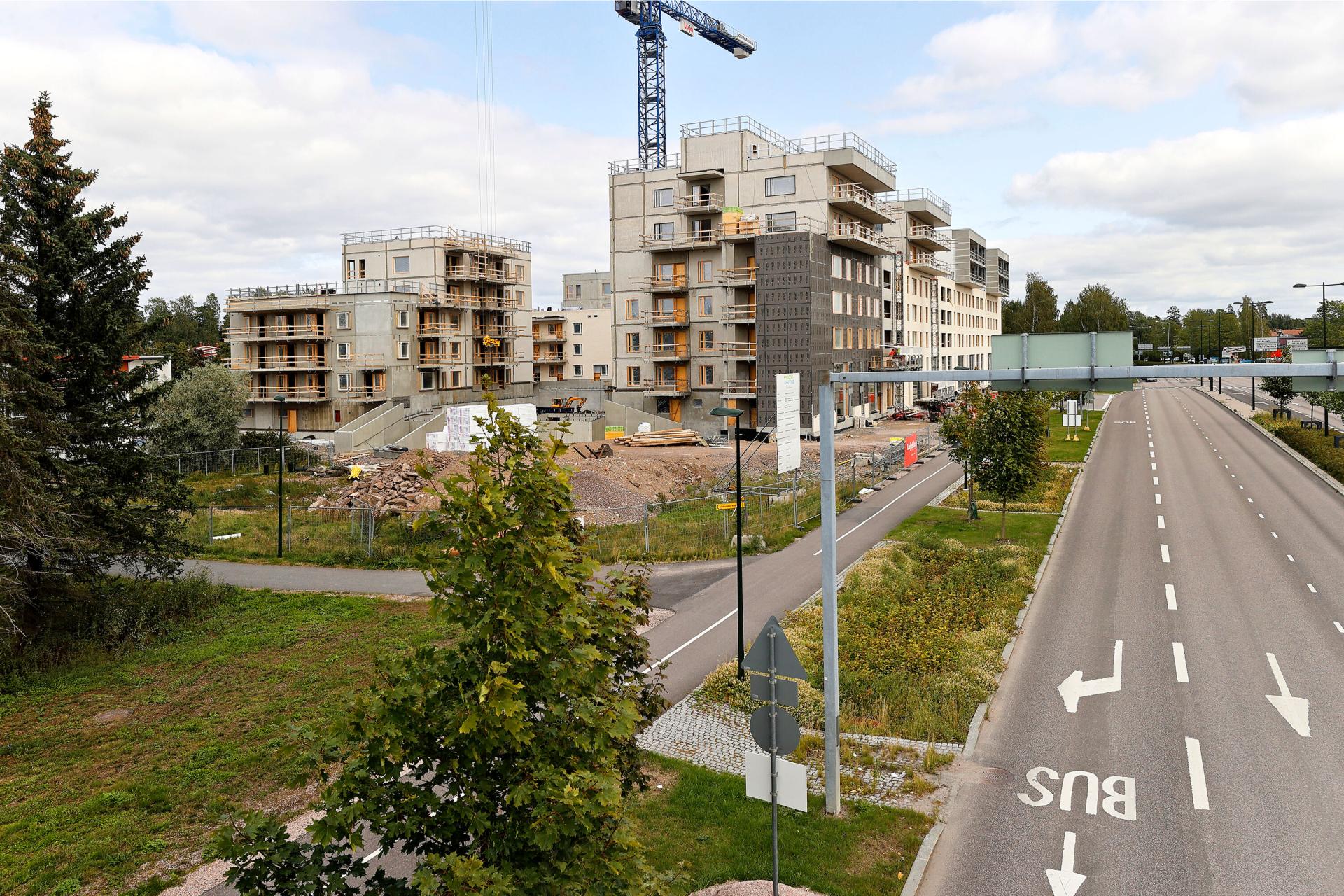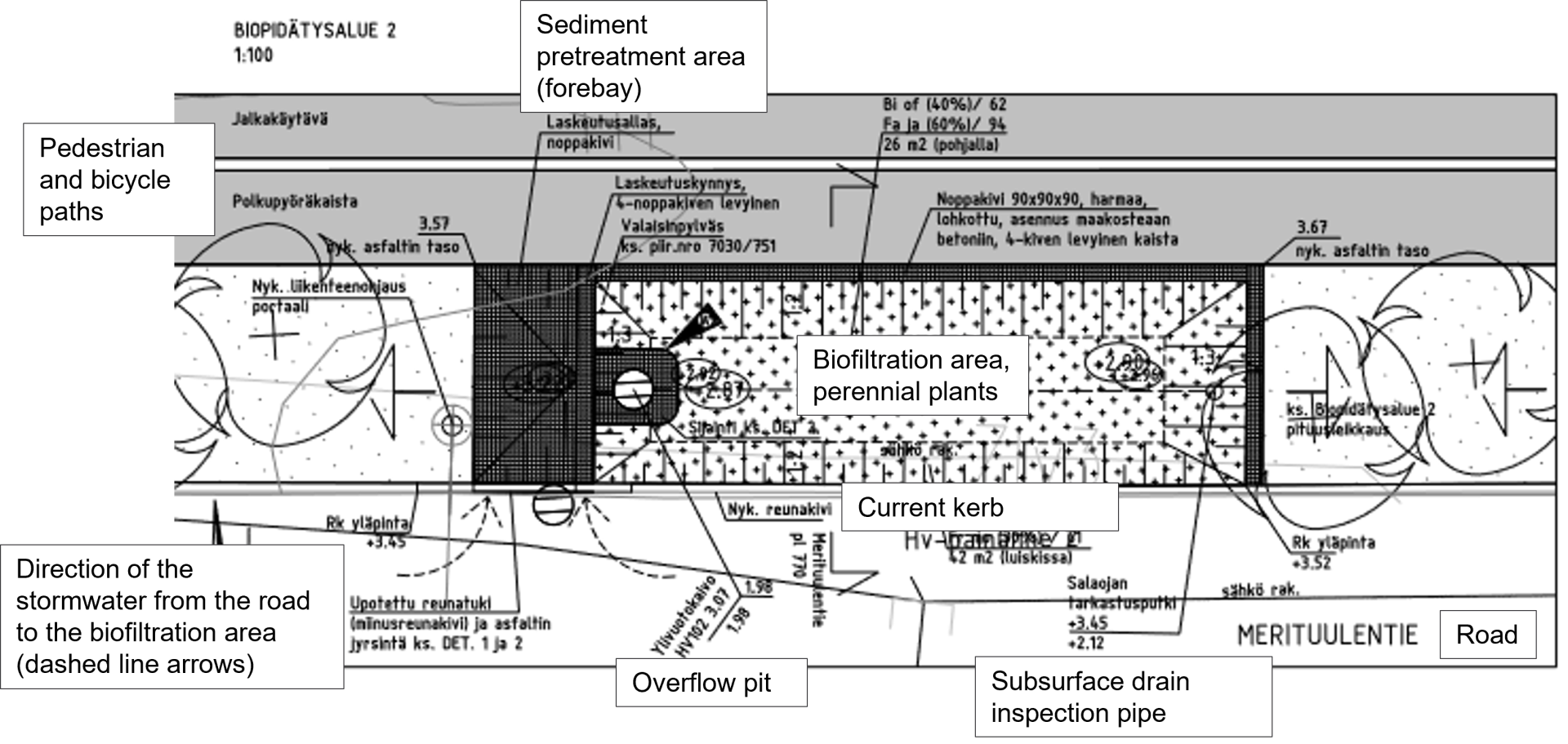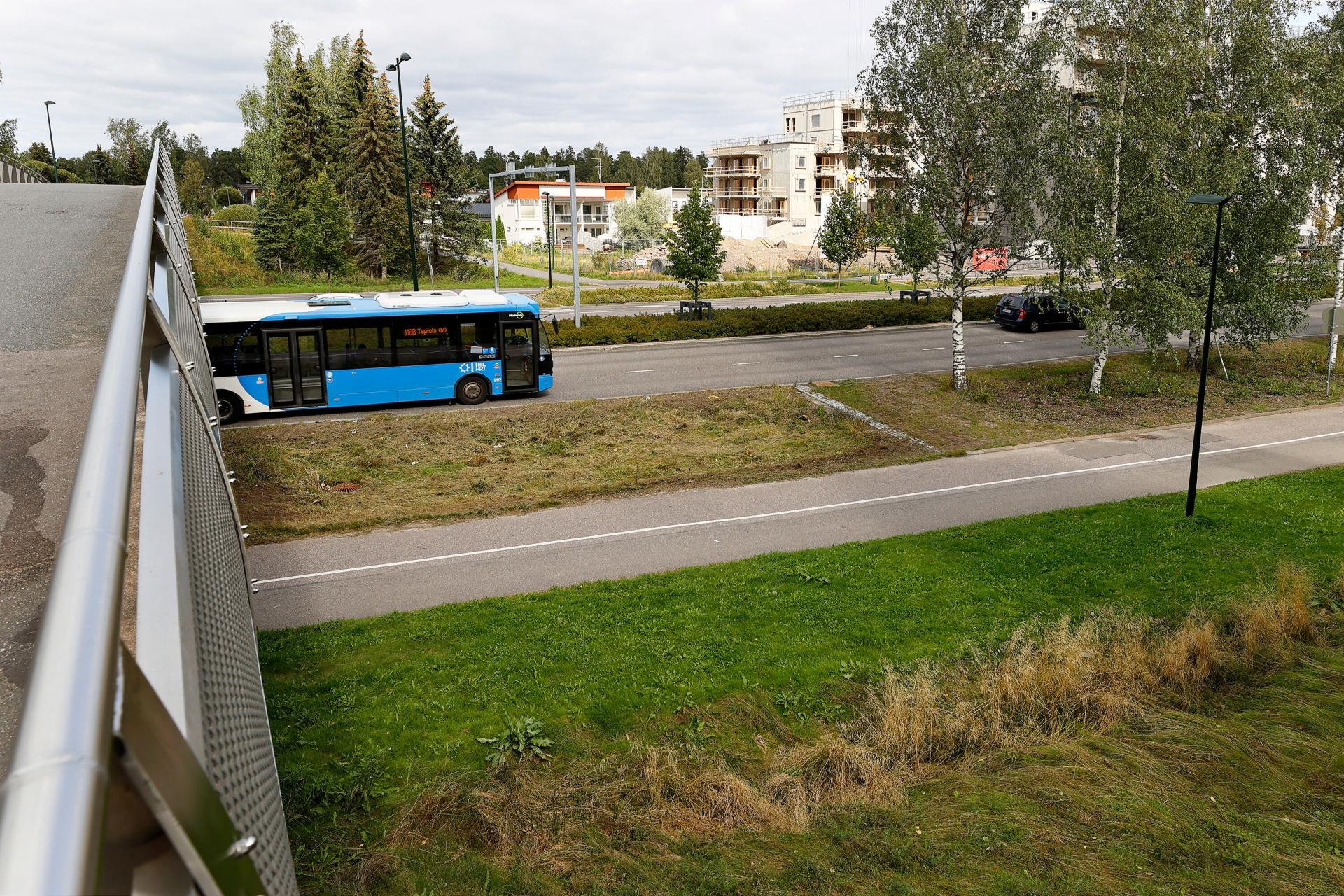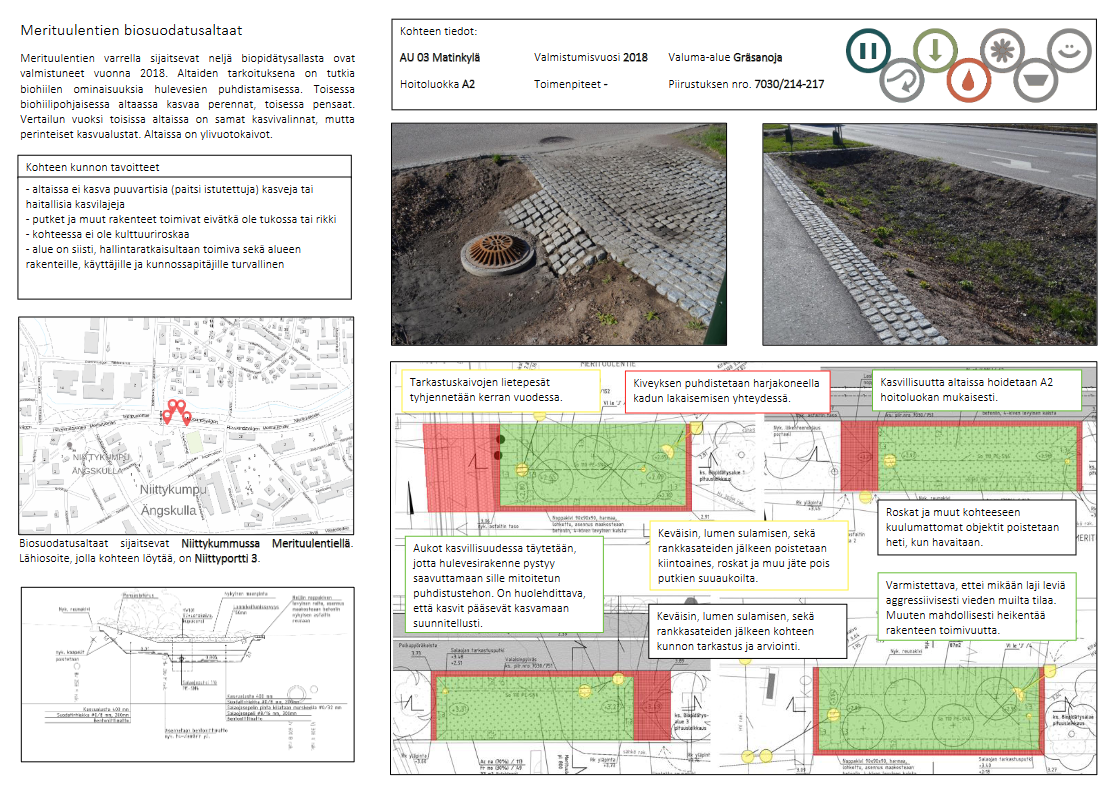Nature-based solutions for stormwater management in the Helsinki Metropolitan Area, Finland – Prerequisites and good practices
Information
Helsinki Region Environmental Services Authority
30.12.2021
Nature-based solutions for stormwater management in the Helsinki Metropolitan Area, Finland – Prerequisites and good practices
Helsinki Region Environmental Services Authority
P.O. BOX 100
00066 HSY
Tel +358 9 1561 2110
Faksi 09 1561 2011
www.hsy.fi
Author: Niina Kautto
Further information:
Maaria Parry, maaria.parry@hsy.fi
Cover photo: HSY/ Mikko Käkelä
Selected stormwater management solutions in Espoo
City of Espoo is the second largest city in Finland. It is characterised by an urban structure relying on five different centres and that is dominated by urban and detached house living close to nature. (City of Espoo n.d.).
Espoo’s population stands currently at 292 800 (2020). In 2030, there are estimated to be 47 300 more inhabitants, growing yearly by about 4700 inhabitants. By 2060 city is anticipated to grow in the fast growth scenario by 187 600 inhabitants. (Espoon kaupunki n.d.a).
The city has the lowest built-up area among the Helsinki Metropolitan Area cities, 20% (60% of the city land area is covered by forests (Espoon kaupunkisuunnittelukeskus 2020, see
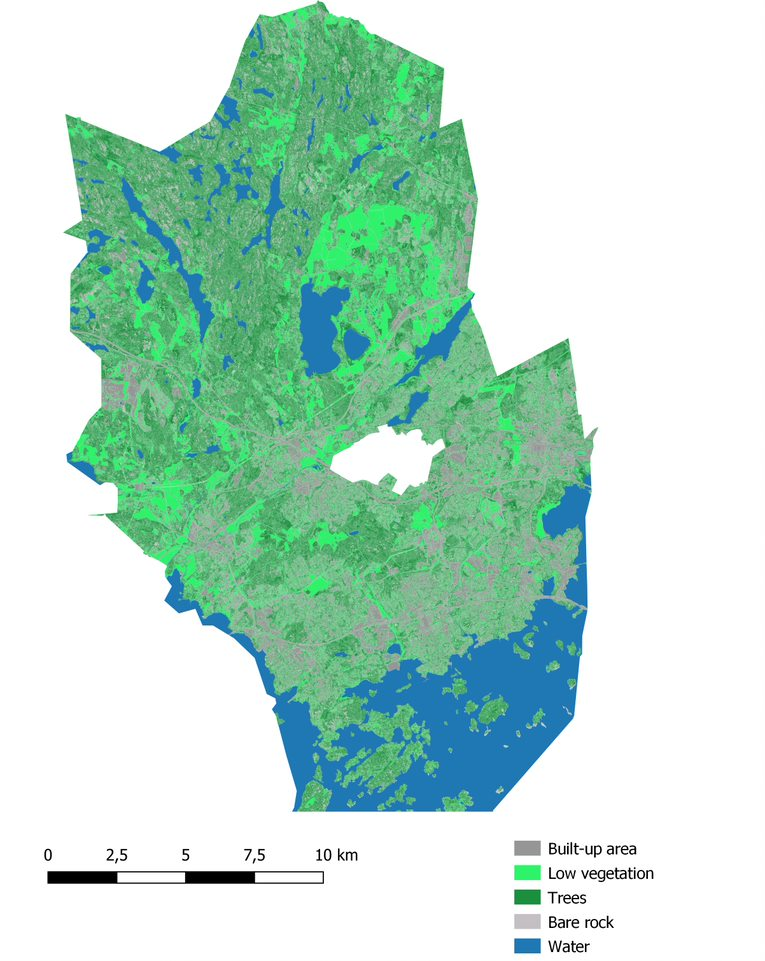
Espoo’s first stormwater management program was accepted by the city council in 2012 (Espoon kaupunki n.d.b.). Already then, the program had an aim to move towards a more natural and integrated stormwater management and commit all city actors to these common goals. This aim is still considered to be timely and important. (Espoon kaupunkisuunnittelukeskus 2020). The 2012 program was updated in 2020 to take into account recent stormwater floods, increased research knowledge, experience gathered in the construction projects as well as changes in the legislation (Espoon kaupunki n.d.b). The update was supported by a thesis work (Airamo 2018).
The aim of the 2020 stormwater management program is that the stormwaters are managed in Espoo as a whole so that the water economy balance is maintained, the ecological state of stormwater receiving watercourses is improved and that the stormwaters cause damage neither to the health, safety and nature nor the attractiveness and functionality of the city. Stormwaters are regarded as a resource and an opportunity to create more sustainable and better environment. The program also aims to consider stormwaters in an integrated manner in land use planning and building. Natural stormwater management methods are used widely, and the stormwater management design and implementation are part of the normal development of the urban form. (Espoon kaupunkisuunnittelukeskus 2020).
The seven main objectives of the stormwater management program are (not in order of importance) (Espoon kaupunkisuunnittelukeskus 2020):
- Increasing the stormwater know-how, awareness and cooperation;
- Improving stormwater management and decreasing stormwater flooding;
- Preventing the damages caused by stormwater quality in the environment;
- Maintaining the urban environment biodiversity and improving the state of waterways;
- Securing the groundwater quality and maintaining its surface level;
- Preparing for climate change; and
- Advancing the benefit perspective of stormwater (such as recreational and practical use).
There are altogether 42 measures in the program, and each of them have been assigned a responsible body. These mostly include city departments and the stormwater working group. Measures are implemented in cooperation with HSY, Western Uusimaa’s rescue department and property owners. (Espoon kaupunkisuunnittelukeskus 2020).
The implementation of the program and related activities are directed by the stormwater working group that consists of relevant representatives of branches of administration. The group was formed as a result of the 2012 program’s goal to improve the internal cooperation in the city organisation. The working group does not decide stormwater related matters but oversees that the measures will be implemented, and the objectives are considered in the work of the branches of administration. It also monitors yearly the program implementation and ensures that the program is up-to-date. (Espoon kaupunkisuunnittelukeskus 2020).
Stormwater management design, building and maintenance are part of the routine work with no extra budget. It is however recognised that developing stormwater management requires additional resources both in terms of person years as well as investments and maintenance. Implementing the program measures is said to be easier in new areas compared to older, densifying areas, and good design is key in cutting costs. Also impacting costs and management options is that the natural stormwater management sites are disappearing along with urban planning. (Espoon kaupunkisuunnittelukeskus 2020).
Assisting with the integrated stormwater management is collecting and recording stormwater data in a user-friendly way. One of the program’s sub-objectives is to develop a stormwater database that includes information on catchment basin properties, sensitive waterways, implemented stormwater management structures and known flood prone sites. This complements the work of HSY in the HUTI project. (Espoon kaupunkisuunnittelukeskus 2020). A maintenance card file was developed as part of a student thesis work of Kymäläinen (2019) that supports in part the implementation of this sub-objective. It used as an example the stormwater card file of Vantaa and was tailored to suit the needs of Espoo’s green maintenance unit. This thesis work found that at the time Espoo had 46 finalised stormwater management sites and 16 sites were in development. (Kymäläinen 2019). The card file is intended to facilitate working together of planners and maintenance staff; it also offers ways to develop old operation models related to stormwater management structures’ maintenance and monitoring, as well as means for a more systematic maintenance (Kymäläinen n.d.). The maintenance cards have not really been updated since their development but they have been brought into a geographic information system directed to municipalities (Trible Locus) to be utilised (informant). Figure 27
The stormwater management program presents operational principles for all the branches of administration to apply in order to meet the program’s objectives (Espoon kaupunkisuunnittelukeskus 2020).
The stormwater management program and its objectives are supported by Espoo’s strategy (Espoo-tarina, i.e. The Espoo Story), as well as the sustainable development program (Kalliala and Lehikoinen 2019).
Huhuilijanpuisto park wetland
Location: Lintuvaara, Helmipöllönmäki
Management / system type: detention and infiltration, conveying
Land use type: Green or natural area
Built: 2013, repaired in 2016
Drainage area: Wetland receives stormwaters from the forest on the northside and a few nearby streets (Helmipöllönkatu, Lintulaaksontie, Korpraalintie) (informant).
Catchment basin: Monikonpuro stream
Description:
This site is situated in eastern Espoo in a forested park with outdoor paths, next to a residential area of single-family houses and apartment blocks (see Fig. 21-23). It is actually a ditch that was built to go through a forest, and the intention was that the flooding water could rise into the forest area. However, after building the structure, it was noticed that water remained high, and the majority of the trees had died. It also decreased the attractiveness of the area. The reason was that the stormwater well blocked easily due to forest litter. (Kymäläinen 2019).
In 2016, the site was planned repair measures and the implementation was starting at the end of the year. It was deemed necessary to repair the well system of the detention area so that the water level would be lower and that would thus create better conditions for the vegetation. In fact, the same issue was found at another, connected site nearby. Repair measures included lowering stormwater well and subsurface drain levels at both sites. Repair costs were estimated 7000-10 000€ together for both sites, and were planned to last for about a week. (Herttua and Hell 2016).
After these measures, the status in the autumn 2021 was that the structure appears to be working well though the brushwood needed to be cleared as part of the routine maintenance. The city informant admitted that it is typical of these types of stormwater management sites that they do not form a functioning whole right away. This can serve as a learning for others.
The intended purpose of this detention area is that the basin is filled momentarily after the rain and this reduces flood risk downstream. The water is purified when detained, and the basin is slowly emptied. Therefore, stormwater basins usually have relatively little amount of water. (informant).
The maintenance objectives of the site include making sure that the site is functioning as intended and that there is no human-related litter. Water can rise only temporarily and only to an area designated to it. The wetland should not include any harmful plant species. The site should be checked and evaluated in the spring, after snow melting and heavy rains. (Kymäläinen 2019).
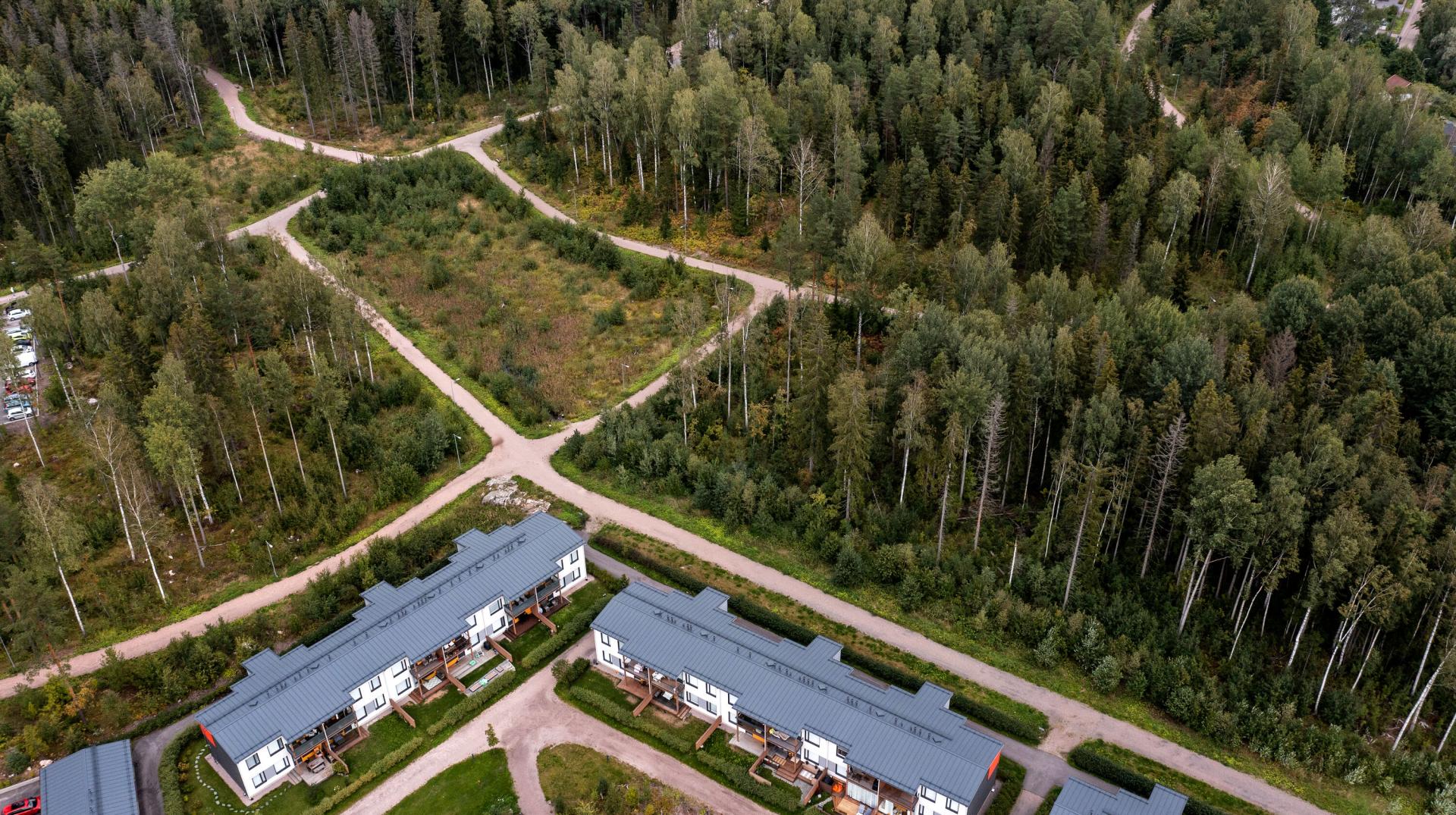
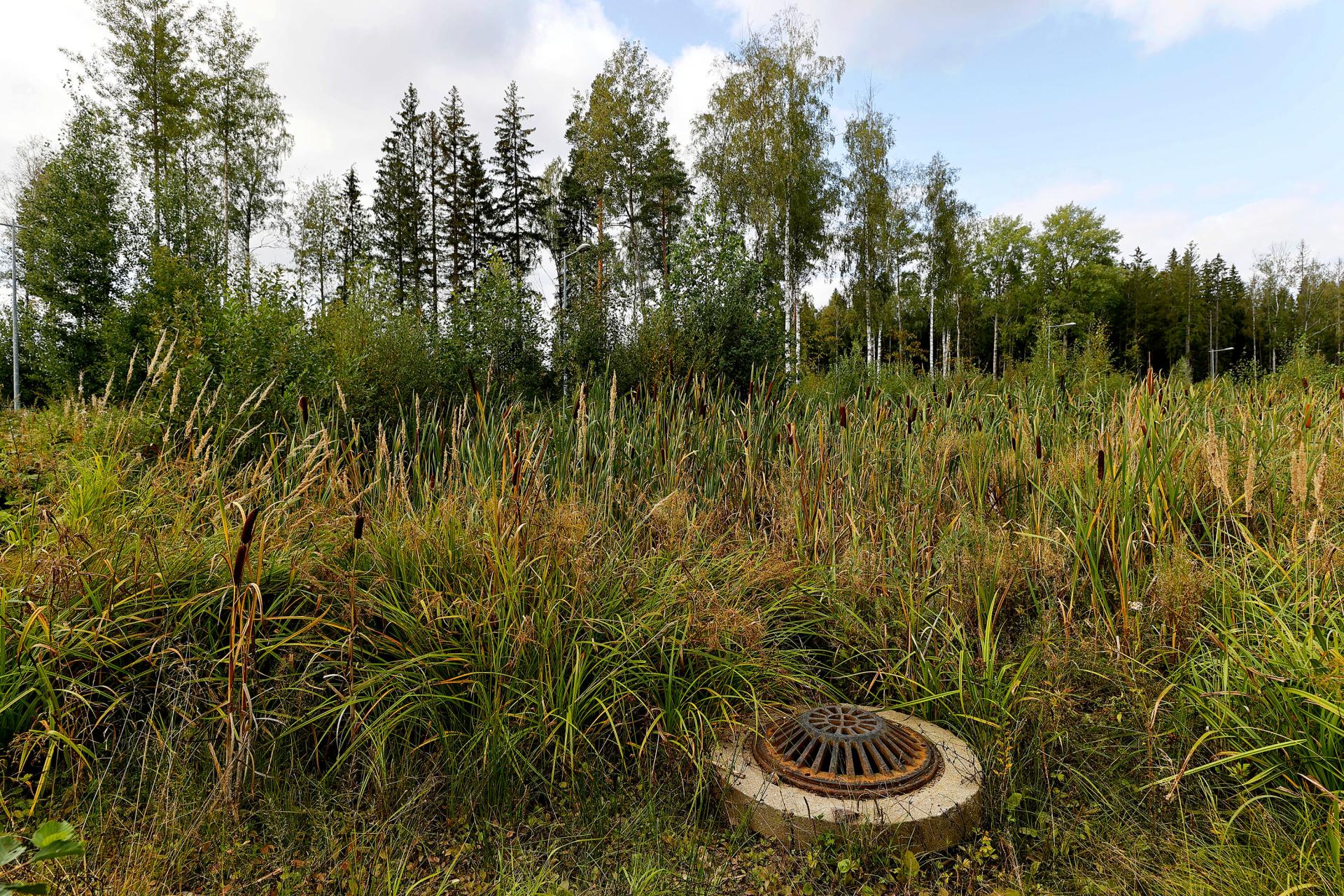
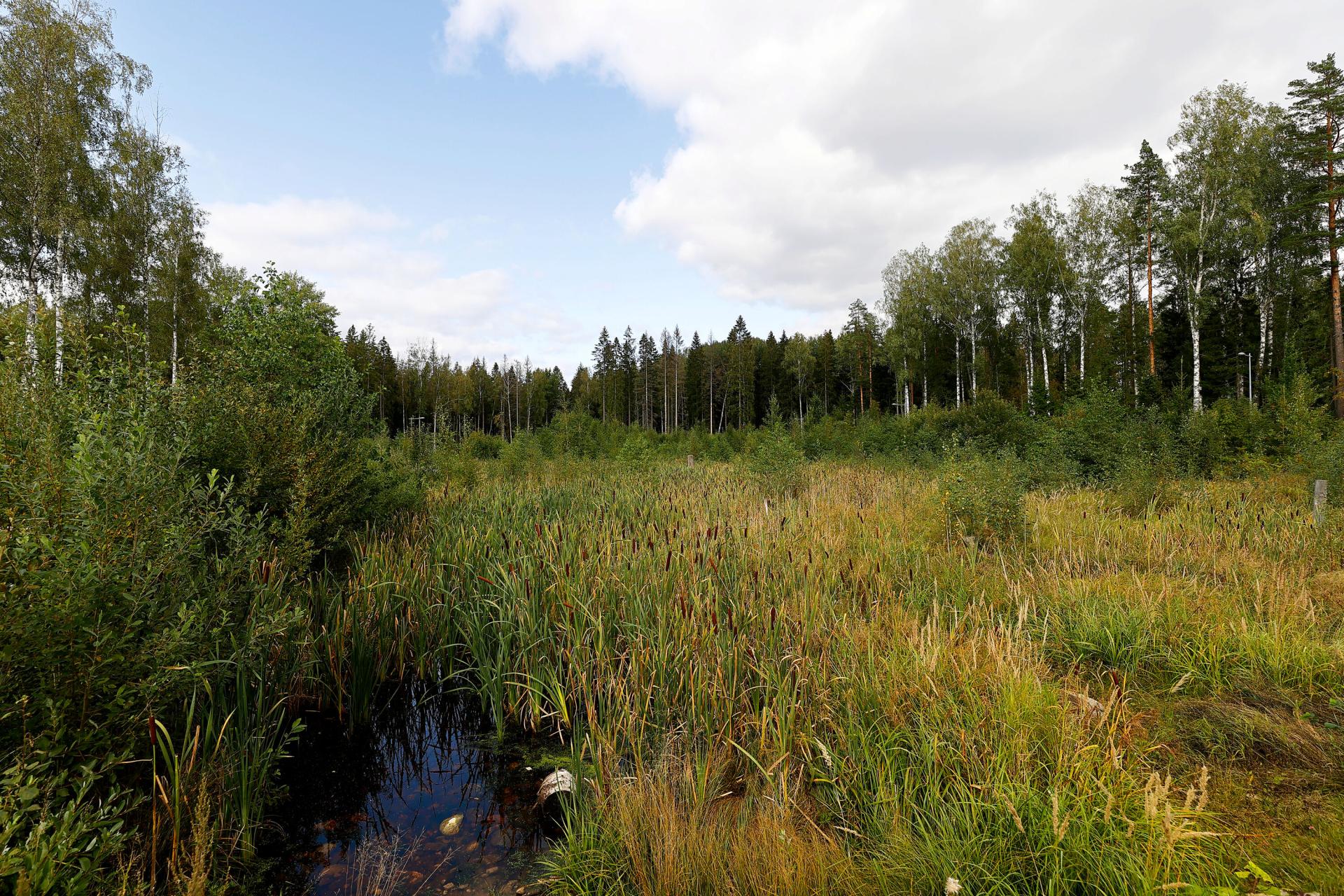
Merituulentie road biofiltration swales
Location: Niittykumpu district, Suur-Tapiola
Management / system type: detention & infiltration
Land use type: densely built-up area / developing (or rural) area
Built: 2018
Drainage area: Gräsanoja creek 24,2 km2, Nässelkärrinoja creek 2,15 km2
Catchment basin: Gräsanoja creek
Description:
The Niittykumpu area has been built mostly in the 1970s, and it is to double its inhabitants from 5000 to 10000. It has highly impermeable surface area, 45-55%. The installation of bioswales on both sides of the Merituulentie road was part of the decentralised stormwater management plan of Niittykumpu. This plan is estimated to be implemented in 2018-2024. The aim of the plan is to reduce flow peaks, as well as to slow down, convey and purify stormwater, with different types of green or nature-based structures. The objective of the flood protection is that the rains occurring once in every 30 years do not cause considerable harm. It is estimated that flow peaks can be reduced by 30% in Niittykumpu drainage area by implementing the stormwater management measures in the plan; also stormwater quality is expected to improve, and therefore also the water quality of receiving waterways in Gräsanoja creek and Suomenlahti bay. (Kalliala and Lehikoinen 2019).
The Espoo Story supports utilising research in new, experimental structures as it describes the city as a responsible pioneer. This in turn means, among other things, having courage to do things in a new way. (Kalliala and Lehikoinen 2019, Kerkkänen et al. 2019).
The swales were built in 2018 on both sides of a busy road, with about 15 000 cars passing per a weekday, in a densely built-up area (see Fig. 24-27). Significant part of the traffic related substance load – such as phosphorus, metal and PAH compounds – are conveyed and accumulated next to the road. Therefore, the road’s stormwaters are optimally treated with biofiltration. (Kerkkänen et al. 2019).
The objective of the bioswales is to manage the quantity and quality of stormwater, and to reduce the nutrient and metal load to the Gräsanoja trout creek were the road's stormwaters flow, and that has flooded in recent years. The aim is to manage cloudbursts occurring every three years. The intention was also to examine the functioning of biofiltration in purifying stormwater. (Kerkkänen et al. 2019).There are four different types of bioswales. Western bioswales are sand-based biofiltration structures whereas the eastern structures were added biochar as a filtration medium. North-side bioswales have perennial plants and paving while the south-side bioswales have been planted bushes and have curbside inlets. (Kymäläinen 2019). Sand has been traditionally used in stormwater filtration due to its properties to retain well most impurities and nutrients (Eckhart et al. 2017 cited in Kerkkänen et al. 2019). Biochar is used to retain phosphorus; water is also aimed to be retained more compared to a normal growth platform (Kerkkänen et al. 2019).
Research (part of the Hule S&C project) included monitoring of the functioning of the systems in 2018, including measuring the water flow and turbidity of incoming and outgoing stormwater (these are indirect quality parameters). Also, a new continuous measurement device was installed to demonstrate monitoring of concentrations of chemical elements. In addition, one of the sand-based structures was taken water samples during two rain events in November. (Kerkkänen et al. 2019).
It was found that during rain events, total suspended solids, phosphorus, chromium, copper and zinc concentrations exceeded Swedish threshold values indicating treatment need (Finland does not have quality criteria for stormwater). However, the (sand-based) biofiltration structure was found to significantly decrease the concentration of several substances in the stormwater, e.g. suspended solids 97%, total phosphorus 63%, and total chromium 76%. (Kerkkänen et al. 2019).
The learnings from this site include(Kerkkänen et al. 2019):
- Biofiltration suits especially well to retain harmful substances that are bound to suspended solids.
- Dry long periods should also be prepared for, not only cloudbursts. Vegetation may need a lot of water in the first year, and hence the structure retains more water also.
- To obtain a good understanding of how the structure functions, a long measurement period in different weather conditions, seasons and in the course of vegetation growth is needed.
- Maintenance need and cleaning frequency of structures must be determined.
- Biodiverse vegetation is searching for its place in correct moisture conditions. Structures and vegetations need to withstand various weather conditions.
- Build structures in the autumn so that they saturate with water in winter and vegetation can start to grow in the spring.
As it can be seen from the photos taken in August 2021, vegetation is doing well on the north
The maintenance card specifies, among other things, that the vegetation needs to be cared for so that it can grow as planned; pavements are cleaned during street cleaning, and – as in the case of Huhuilijanpuisto park site – the bioswales ought to be checked and evaluated in the spring, after snow melting and cloudbursts. (Fig. 27, Espoon kaupunki, n.d.c, Kymäläinen 2019).
